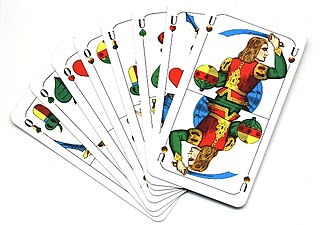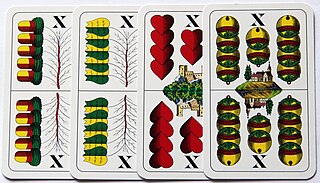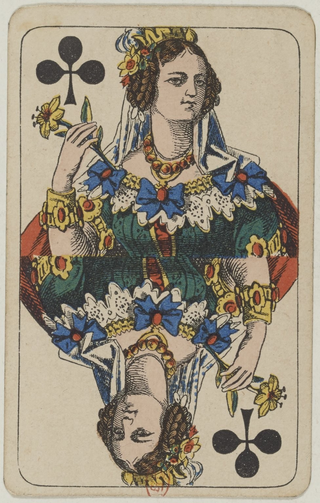
Schafkopf, also called Bavarian Schafkopf, is a popular German trick-taking card game of the ace–ten family for four players that evolved, towards the end of the 19th century, from German Schafkopf. It is still very popular in Bavaria, where it is their national card game played by around two million people, but it also played elsewhere in Germany and in Austria. It is an official cultural asset and important part of the Old Bavarian and Franconian way of life. Schafkopf is a mentally demanding pastime that is considered "the supreme discipline of Bavarian card games" and "the mother of all trump games."

Doppelkopf, sometimes abbreviated to Doko, is a trick-taking card game for four players.

Cego is a Tarot card game for three or four players played mainly in and around the Black Forest region of Germany. It was probably derived from the three-player Badenese game of Dreierles when soldiers deployed from the Iberian Peninsula during the Napoleonic Wars and, based on a Spanish game they had encountered, introduced Cego's distinctive feature: a concealed hand, or blind. Cego has experienced a revival in recent years, being seen as part of the culture of the Black Forest and surrounding region. It has been called the national game of Baden and described as a "family classic".
Elfern or Elfmandeln, is a very old, German and Austrian 6-card, no-trump, trick-and-draw game for two players using a 32-card, French-suited Piquet pack or German-suited Skat pack. The object is to win the majority of the 20 honours: the Ace, King, Queen, Jack and Ten in a Piquet pack or the Ace, King, Ober, Unter and Ten in a Skat pack. Elfern is at least 250 years old and a possible ancestor to the Marriage family of card games, yet it is still played by German children.
Réunion, Reunion or Vereinigungsspiel is an historical German point-trick game for three players which, despite its French name, appears to have originated in the central Rhineland and lowland areas to the east. It is a 10-card game of the ace–ten family and uses a 32-card French-suited piquet pack or 32-card Skat pack. Players who cannot follow suit must trump. Otherwise the game can be described as a simplified version of Skat, but is also reminiscent of Euchre with its two permanent top trumps, the Right and Left Bowers.

German solo or just solo is a German 8-card plain-trick game for 4 individual players using a 32-card, German- or French-suited skat pack. It is essentially a simplification of quadrille, itself a 4-player adaptation of ombre. As in quadrille, players bid for the privilege of declaring trumps and deciding whether to play alone or with a partner. Along with ombre, Tarock and Schafkopf, German solo influenced the development of skat. Parlett calls it a "neat little descendant of Quadrille" and "a pleasant introduction" to the ombre family of games.

Tippen, also known as Dreiblatt, Dreikart, Drei Karten, Dreekort, Kleinpréférence or Labet, is an historical German 3-card, plain-trick game which was popular as a gambling game for three or more players. The Danish version of the game was known as Trekort and more elaborate Swedish variants include Knack and Köpknack. It appears to be related to the English game of Three-Card Loo. It was banned as a gambling game in some places.
Ramsch, formerly also called Mike in East Germany, is a card game based on the contract of the same name in the popular German card games, Skat and Schafkopf. However, thanks to its interesting mode of play it has since developed into an independent game in its own right which is only loosely based on Skat or Schafkopf. It should not be confused with the games of the Rams family – Ramsen and Ramscheln – that also go by the name Ramsch.

Officers' Skat (Offiziersskat), is a trick-taking card game for two players which is based on the rules of Skat. It may be played with a German or French pack of 32 cards which, from the outset of the game, are laid out in rows both face down and face up. As in Skat, tricks are taken and card points counted to determine the winner of a round; game points are then awarded to decide the winner of a game. There are several local variations of the game, which differ mainly in the number of cards revealed or hidden and the calculation of points.

German Schafkopf is an old German, ace–ten card game that is still played regionally in variant form today. It is the forerunner of the popular modern games of Skat, Doppelkopf and Bavarian Schafkopf. It originated in Leipzig in the Electorate of Saxony. Today it is hardly ever played in its original form, but there are a number of important national and regional derivations.

Gaigel is a card game from the Württemberg region of Germany and is traditionally played with Württemberg suited cards. It is a Swabian variant of Sechsundsechzig and may be played with 2, 3, 4 or 6 players. However, a significant difference from Sechsundsechzig and other related games like Bauernschnapsen is the use of a double card deck. The four-player game is usually called Kreuzgaigel. The game emerged in the early 19th century.

Bavarian Tarock or, often, just Tarock, is a card game that was once popular in Bavaria and also played in parts of Austria as well as Berlin. The name is a clue to its origin in the historical German game of [Gross-]Tarock, a game using traditional Tarot cards. At some point in the mid- to late-18th century, attempts were made to emulate Taroc using a standard 36-card German-suited pack, resulting in the formerly popular, south German game of German Tarok. During the last century, the variant played with a pot (Haferl) and often known as Bavarian Tarock or Haferltarock, evolved into "quite a fine game" that, however, has less in common with its Tarock progenitor. German Tarok also generated the very similar game of Tapp, played in Württemberg, and both are related to Bauerntarock, Dobbm and the American games of frog and six-bid solo.

Tapp is a trick-taking, card game for 3 or 4 players using 36 French-suited cards that is played in the south German region of Swabia, especially in the former Kingdom of Württemberg. It is the French-suited offshoot of German Tarok; its German-suited form being called Württemberg Tarock in that region. Tapp is one of a family of similar games that include Bavarian Tarock, the Austrian games of Bauerntarock and Dobbm, and the American games of frog and six-bid solo. Although probably first played in the early nineteenth century, the game of Tapp is still a local pastime in its native Württemberg, albeit in a greatly elaborated form.

Binokel is a card game for two to eight players that originated in Switzerland as Binocle, but spread to the German state of Württemberg, where it is typically played with a Württemberg pattern pack. It is still popular in Württemberg, where it is usually played in groups of three or four as a family game rather than in the pubs. In three-hand games, each player competes for himself, while in four-hand games, known as Cross Binokel (Kreuzbinokel), two teams are formed with partners sitting opposite one another. The game was introduced to America by German immigrants in the first half of the 20th century, where it developed into the similar game of pinochle. Binocle was still played in Switzerland in 1994. In south Germany, the game is sometimes called by its Swabian name, Benoggl.

An ace–ten game is a type of card game, highly popular in Europe, in which the aces and tens are of particularly high value.

Blattla is a Bavarian card game for four players, who usually form two teams of two for each deal. It is a simplified version of Schafkopf and Bierkopf and is thus a point-trick game. Unlike those two games, in Blattla the Obers and Unters are not permanent trumps. In order to learn the rules of Schafkopf, it can be an advantage to first become familiar with Blattla. The game is traditionally played with Bavarian pattern cards.

Matzlfangen is a traditional point-trick, card game for 4 players that originated in the Bavarian province of Upper Palatinate over 200 years ago and spread to Austria. It is still played in a few places today. The game is named after the ten or Matzl, which plays a key role.

Officers' Schafkopf is a German point-trick card game for two players which is based on the rules of Schafkopf. The game is a good way to learn the trumps and suits for normal Schafkopf and to understand what cards one is allowed to play. It is similar in concept to Officers' Skat.
Zwanzig ab, 20 ab or simply Zwanzig is card game for four players. It is a member of the Rams family in which the key feature is that players may choose to drop out of the game if they believe their hand is not strong enough to take a minimum number of tricks. It appears to be a recent, internet-propagated variant of Schnalzen or Bohemian Watten. However, the latter has a natural card ranking, is played with double German cards and a Weli, has no exchanging and has a different scoring system. It is suitable for children from 8 upwards. It may be related from Fünf dazu! which is a simpler game described by Gööck in 1967 that has neither trumps nor the option to drop out.

Sjavs is a Danish card game of the Schafkopf family that is played in two main variants. In Denmark, it is a 3-player game, played with a shortened pack of 20 cards; in the Faroe Islands, where it is very popular, it is a four-hand, partnership game using a standard piquet pack of 32 cards.
![]() Q and
Q and ![]() Q, or, in a German- suited pack, the two top Obers,
Q, or, in a German- suited pack, the two top Obers, ![]() O and
O and ![]() O, are known as the Old Ones (Alten). The players with the Old Ones play as partners against the other two. [9]
O, are known as the Old Ones (Alten). The players with the Old Ones play as partners against the other two. [9] 













